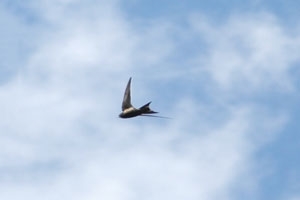Swifts
 The month of August sees the last remaining swifts leave our shores. The newly fledged youngsters only have a few day’s flying practice before they must start the long journey south through France, Spain and across Africa to the main over-wintering areas in Zaire and Malawi. Swifts sleep on the wing – often between 1,000 and 2,000 metres up, so these youngsters have no need to land – in fact the next time they land again may well be when they want to find a mate and breed – in two to four years time!
The month of August sees the last remaining swifts leave our shores. The newly fledged youngsters only have a few day’s flying practice before they must start the long journey south through France, Spain and across Africa to the main over-wintering areas in Zaire and Malawi. Swifts sleep on the wing – often between 1,000 and 2,000 metres up, so these youngsters have no need to land – in fact the next time they land again may well be when they want to find a mate and breed – in two to four years time!
Swifts mate for life and usually don’t breed until they are four years old – the longest-living swift ever recorded in this country was a ringing return from a bird of 21 years of age! The two or three white eggs are laid over a period of a week or so, but incubation starts once the first egg is laid, resulting in different aged chicks in the same nest. If insect abundance is good, all the chicks will fledge, but if weather conditions are poor and insects difficult to find, the smaller chicks may die.
Bad weather conditions and its impact on insect abundance can play a major part in the swift’s day-to-day life. If a large depression occurs, swifts may temporarily leave the breeding area and skirt around the bad weather, sometimes being away for a few days at a time and travelling up to 800km each day.
This time away from eggs or chicks would spell complete disaster for all other birds, but not swifts. Their eggs can survive chilling and simply stop growing until incubation starts again, sometimes delaying hatching for up five days or so. Likewise, the chicks when left go into a semi-torpid state and cease growing, which can delay fledging for up to two weeks!
Adult swifts have very small beaks but a huge gape into which they catch tiny flying insects. They create a “ball” of thousands of these insects and store them in a special pouch in the back of the throat, later feeding this protein-rich food to their young. About a week before the young swiftlets are due to leave the nest, the parents abandon them.
The young birds are very fat – indeed far too fat to fly and their wing feathers have not yet fully formed, so the last week in the nest is spent growing wing feathers and reaching the correct flying weight. The day finally arrives when they must leave the safety of the roof space, having only ever flapped wings in practice; they must launch themselves out from under the eaves into the outside world. This is perhaps more dangerous than you might imagine, as swifts have tiny feet (their scientific name “apus” means “no foot”) and should they fall to the ground they are doomed as they are completely unable to take off again. Should you ever find a young swift that appears to be unharmed, simply take it to an upstairs window and let it launch itself back into the air!
When handling swifts, you may well spot louse flies, which are surprisingly big (7mm) and have flattened bodies, enabling them to move around under the feathers, sucking the bird’s blood while travelling at high speed! The fly’s pupae stay in the nest over the winter months and re-infest the chicks the following summer.
Peter Thompson
Advisory

Download Peter Thompson's essential 26-page book, featuring beautiful photography and detailed profiles of Britain's wildlife
Download FREE >